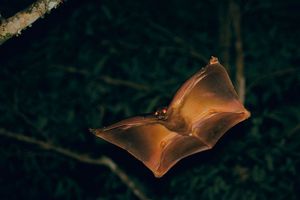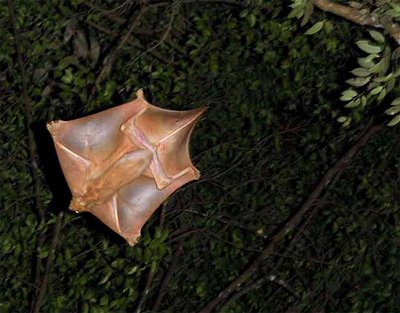The Mayan Colugo (Galeopterus variegatus) is a small mammal, about 34-40 cm in length and 1-2kg, which inhabits the dense forests of Southeast Asia. Recently, it has been discovered that the Colugo is actually the closest living relative of primates, making it a hot topic in evolutionary biology. It is nocturnal and feeds on young leaves, requiring it to visit many trees in one night. This explains its unusual evolutionary adaption, it glides! By gliding it can visit many more trees in one night. The Malayan Colugo can leap out of a tree and glide up to 110 meters by using their highly developed, and relatively large, patageum.

The Colugo has the most developed patageum of any gliding mammal. Not only does it reach from its arms to its legs, it also connects the arms, the neck, the legs, and the tail. Scientists, wishing to study the flight characteristics of the Colugo glued accelerometers to their backs, and collected some surprising data.
It turns out that the Colugo encounters equal or less landing forces when it has been flying for a long period of time in comparison with short flights. This seems counter intuitive, considering one would expect the animal’s speed to increase with time, yet there may be an interesting explanation.

One hypothesis is that since the Colugo lands vertically on a tree the majority of the time, yet glides horizontally, it somehow uses its patageum to create aerodynamic forces that rotate it into a vertical position. As the animal rotates, it also decreases its approach speed, as it is now in a state of highly increased drag. It must start this rotation by adjusting the position of its patageum in some way.
The specific movement that causes this adjustment in aerodynamic forces is still unknown. Could an experiment in a controlled environment with high-speed cameras, similar to Professor Full’s air righting gecko experiment, be the key to discovering exactly how the Colugo maneuvers in the air?
References:
Norris, Scott. “Flying Lemurs are Primates’ Closest Kin.” Nationalgeographic.com. National Geographic. Web. September 22, 2011. http://news.nationalgeographic.com/news/2007/11/071101-lemur-relative.html.
Byrnes, Greg, Lim, Norman, Spence, Andrew. “Take-off and landing kinetics of a free-ranging gliding mammal, the Malayan colugo (Galeopterus variegatus).” The Royal Society. Web. September 22, 2011. http://rspb.royalsocietypublishing.org/content/275/1638/1007.full
Than, Ker. “Flying Lemurs with “Backpacks” Reveal Secrets.” Nationalgeographic.com. Web. September 22, 2011. http://news.nationalgeographic.com/news/2008/02/080212-lemur-backpacks.html
“Gliding Colugos.” BBC.co.uk. BBC. Web. September 22, 2011. http://www.bbc.co.uk/nature/life/Sunda_Flying_Lemur#p0038s8x
2 Comments
Lorena Barba posted on September 23, 2011 at 10:22 am
Very intriguing post, Alex. So, after a short glide, the landing is rough, and for a smoother landing the glide has to be longer!
Kevin Ma posted on September 24, 2011 at 2:03 pm
I’m very curious as to how it manages to rotate in the air.